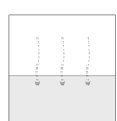Infiltration elements
An infiltration element provides good contact between water and soil, thus allowing water flowing in from adjoining areas to seep or infiltrate into the ground. The term infiltration refers to the process by which water enters the ground from the atmosphere, whereas percolation refers to the movement of water in the ground. The term infiltration is used here for both processes. All infiltration elements must be fitted with an attenuation element, because water cannot seep into the ground at the same rate at which it flows into the area from paved areas. The correct dimensioning of infiltration elements is complicated by the lack of knowledge about the hydraulic conductivity of the earth, which can be particularly variable in cities after many years of construction activities (Craul 1999). Although the hydraulic conductivity of many clay soils is low, this is not necessarily the case if the soil structure is good. As well as direct measurements, the hydraulic conductivity of soil can also be assessed from the soil structure at the surface (good crumb), richness of the vegetation (good growth, deep root network), incidence of large earthworms and general drainage conditions (rainwater seeps away fast, no problems with surface water). Infiltration elements must be drained off after one to three days. Elements that infiltrate directly into raw soil and have therefore not passed through a biologically active layer of humus are associated with special risk and may also be in direct contact with groundwater flow layers or cracks
Craul, P.J. 1999. Urban soils: applications and practices. John Wiley and Sons, USA.

Figure 1: Infiltration (Pictogram: Marit Reisegg Myklestad)

